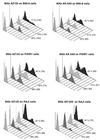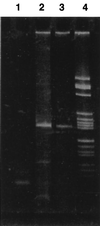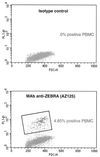Sequential use of paraformaldehyde and methanol as optimal conditions for the direct quantification of ZEBRA and rta antigens by flow cytometry
- PMID: 10702494
- PMCID: PMC95850
- DOI: 10.1128/CDLI.7.2.206-211.2000
Sequential use of paraformaldehyde and methanol as optimal conditions for the direct quantification of ZEBRA and rta antigens by flow cytometry
Abstract
A technique was developed with flow cytometry to quantify the two immediate-early proteins ZEBRA and Rta, which are involved in the activation of Epstein-Barr virus replication. We evaluated four monoclonal antibodies on four cell lines (B95-8, RAJI, Namalwa, and P3HR1) with varying levels of expression of these replication-phase antigens. The Namalwa lymphoma cell line was used as a negative control. Four fixation-permeabilization procedures were compared. The preparation of cells with paraformaldehyde and methanol in sequence, and antigen detection with AZ125 and AR 5A9 monoclonal antibodies, were found to be the optimal conditions in these cell lines. Our procedure allowed ZEBRA antigen to be detected in 4.85% of peripheral blood mononuclear cells from a transplant recipient with a lymphoproliferative disease.
Figures



Similar articles
-
Construction and characterization of monoclonal antibodies specific for the R transactivator 185 of Epstein-Barr virus.J Virol Methods. 2007 Sep;144(1-2):12-6. doi: 10.1016/j.jviromet.2007.03.011. Epub 2007 May 29. J Virol Methods. 2007. PMID: 17532480
-
Sequential paraformaldehyde and methanol fixation for simultaneous flow cytometric analysis of DNA, cell surface proteins, and intracellular proteins.Cytometry. 1992;13(4):432-44. doi: 10.1002/cyto.990130414. Cytometry. 1992. PMID: 1382010
-
Role of the epstein-barr virus RTA protein in activation of distinct classes of viral lytic cycle genes.J Virol. 1999 Dec;73(12):9858-66. doi: 10.1128/JVI.73.12.9858-9866.1999. J Virol. 1999. PMID: 10559298 Free PMC article.
-
[Expression of ZEBRA protein of Epstein-Barr virus in Hungarian patients with Hodgkin lymphoma: latent or lytic cycle?].Orv Hetil. 2006 Aug 20;147(33):1539-44. Orv Hetil. 2006. PMID: 17037676 Hungarian.
-
Transforming growth factor beta 1 stimulates expression of the Epstein-Barr virus BZLF1 immediate-early gene product ZEBRA by an indirect mechanism which requires the MAPK kinase pathway.J Virol. 2000 Jul;74(13):5810-8. doi: 10.1128/jvi.74.13.5810-5818.2000. J Virol. 2000. PMID: 10846060 Free PMC article.
Cited by
-
Epstein-Barr virus latency type and spontaneous reactivation predict lytic induction levels.Biochem Biophys Res Commun. 2016 May 20;474(1):71-75. doi: 10.1016/j.bbrc.2016.04.070. Epub 2016 Apr 16. Biochem Biophys Res Commun. 2016. PMID: 27091426 Free PMC article.
-
Lytic EBV infection investigated by detection of Soluble Epstein-Barr virus ZEBRA in the serum of patients with PTLD.Sci Rep. 2017 Sep 5;7(1):10479. doi: 10.1038/s41598-017-09798-7. Sci Rep. 2017. PMID: 28874674 Free PMC article. Clinical Trial.
-
BZLF1 governs CpG-methylated chromatin of Epstein-Barr Virus reversing epigenetic repression.PLoS Pathog. 2012 Sep;8(9):e1002902. doi: 10.1371/journal.ppat.1002902. Epub 2012 Sep 6. PLoS Pathog. 2012. PMID: 22969425 Free PMC article.
-
Cross talk between EBV and telomerase: the role of TERT and NOTCH2 in the switch of latent/lytic cycle of the virus.Cell Death Dis. 2015 May 28;6(5):e1774. doi: 10.1038/cddis.2015.145. Cell Death Dis. 2015. PMID: 26018735 Free PMC article.
-
Oncogenic Properties of the EBV ZEBRA Protein.Cancers (Basel). 2020 Jun 5;12(6):1479. doi: 10.3390/cancers12061479. Cancers (Basel). 2020. PMID: 32517128 Free PMC article. Review.
References
-
- Brousset P, Knecht H, Rubin B, Drouet E, Chittal S, Meggetto F, Al Saati T, Bachmann E, Denoyel G, Sergeant A, Delsol G. Demonstration of Epstein-Barr virus replication in Reed-Sternberg cells of Hodgkin's disease. Blood. 1993;82:872–876. - PubMed
-
- Crouch J, Leitenberg D, Smith B R, Howe J G. Epstein-Barr virus suspension cell assay using in situ hybridization and flow cytometry. Cytometry. 1997;29:50–57. - PubMed
-
- Drouet E, Chapuis-Cellier C, Garnier J L, Touraine J L. Early detection of Epstein-Barr virus infection and meaning in transplant patients. In: Touraine J L, et al., editors. Cancer in transplantation. Prevention and treatment. Dordrecht, Netherlands: Kluwer Academic Publishers; 1996. pp. 207–213.
MeSH terms
Substances
LinkOut - more resources
Full Text Sources
Other Literature Sources
Research Materials

